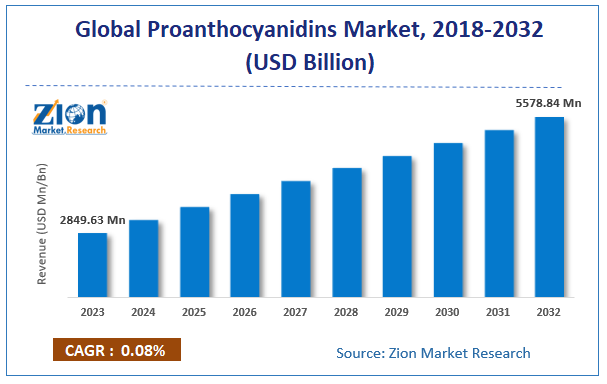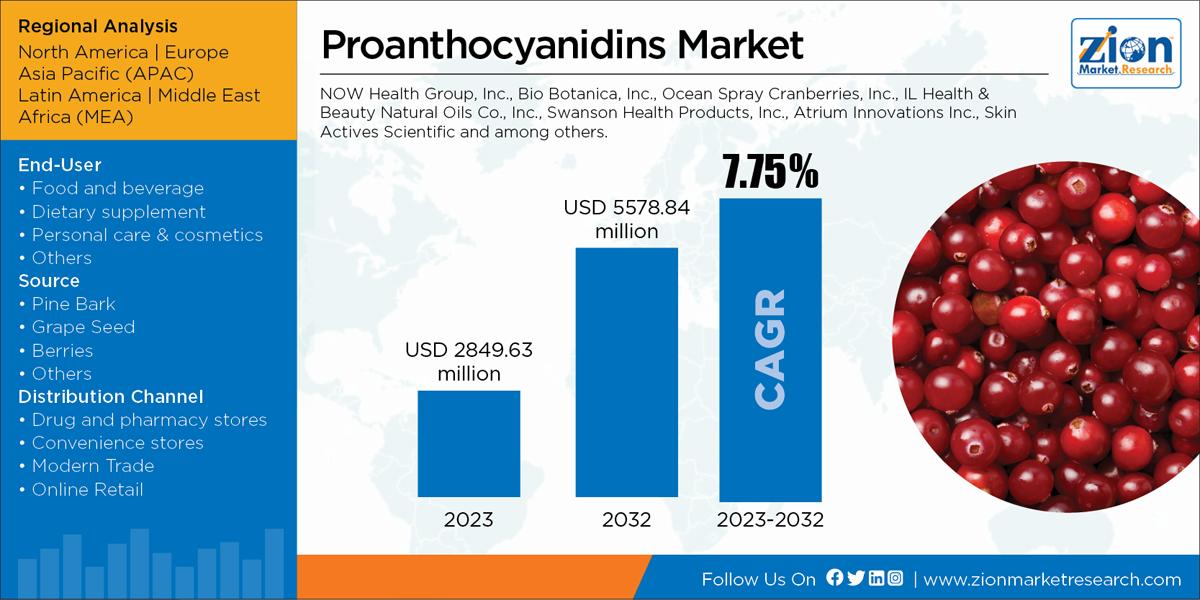Proanthocyanidins Market Size, Share, Demand, Trends, Growth 2032

Proanthocyanidins Market By End-User [Food and beverage, Dietary supplement, Personal care, & cosmetics, Others], By Source [Pine, Bark Grape, Seed Berries, Others], By Distribution Channel [Drug, and pharmacy stores Convenience, stores Modern, Trade Online, Retail], And By Region - Global And Regional Industry Overview, Market Intelligence, Comprehensive Analysis, Historical Data, And Forecasts 2024 - 2032
| Market Size in 2024 | Market Forecast in 2032 | CAGR (in %) | Base Year |
|---|---|---|---|
| USD 2849.63 million | USD 5578.84 million | 7.75% | 2023 |
The global proanthocyanidins market size was worth around USD 2849.63 million in 2023 and is predicted to grow to around USD 5578.84 by 2032 with a compound annual growth rate (CAGR) of roughly 7.75% between 2024 and 2032.
The proanthocyanidins market is expected to witness substantial growth within the forecast period on account of the growth of the dietary supplement industry in several regions across the globe. Proanthocyanidins are utilized in a wide range of applications to provide a health benefit. When incorporated in a dietary food, the proanthocyanidins help in strengthening capillaries, lowering down blood pressure and slowing down the progression of diabetic retinopathy. Proanthocyanidins also known as condensed tannins, are oligomeric flavonoid which has powerful antioxidants properties and are found in food sources such as grapes (seeds and skins), apples, pine bark, red wines, cranberries, blueberries, unsweetened baking chocolate, bilberries, and hazelnuts. Its antioxidant and other therapeutic properties have made proanthocyanidin supplements gain traction in the global market. The therapeutic sector is expected to drive the growth of the proanthocyanidins market within the forecast period.
Due to increase in lifestyle-related diseases, people are opting for healthier lifestyle and food. Proanthocyanidins protect and reduce the oxidative damage caused by free radicals in the body; it also helps in preventing heart-related diseases as many studies have shown that proanthocyanidins reduce blood pressure and improve fat metabolism, moreover, some studies claim proanthocyanidins to have anti-cancer and antitumor activity. These are the factors anticipated to fuel the growth of global proanthocyanidins market over the forecast period. Additionally, the major restraint for the proanthocyanidins market is low market penetration and the lack of consumer awareness about proanthocyanidins in the emerging and developing markets. This is expected to restrain the growth of global proanthocyanidins market over the forecast period.
The study encompasses a market attractiveness analysis, wherein segments are benchmarked based on their market size, growth rate, and general attractiveness.
Proanthocyanidins Market Segmentation Analysis
The proanthocyanidins market can be segmented based on end use application, distribution channel, source, and region. Based on end use application, the proanthocyanidins market can be bifurcated into a dietary supplement, food and beverage, personal care & cosmetics, and others. Dietary supplement & food and beverage accounted for the largest market share among end user in 2023.
On the basis of the distribution channel, the market is bifurcated into direct and indirect sales. Indirect sales can be further bifurcated into modern trade, drug and pharmacy stores, online retail, and convenience stores. On the basis of source, the market is bifurcated into grape seed, pine bark, berries and others.
Proanthocyanidins Market: Report Scope
| Report Attributes | Report Details |
|---|---|
| Report Name | Proanthocyanidins Market Research Report |
| Market Size in 2024 | USD 2849.63 Million |
| Market Forecast in 2032 | USD 5,578.84 Million |
| Growth Rate | CAGR of 7.75% |
| Number of Pages | 215 |
| Key Companies Covered | NOW Health Group, Inc., Bio Botanica, Inc., Ocean Spray Cranberries, Inc., IL Health & Beauty Natural Oils Co., Inc., Swanson Health Products, Inc., Atrium Innovations Inc., Skin Actives Scientific and among others |
| Segments Covered | By End-User, By Source, By Distribution Channel and By Region |
| Regions Covered | North America, Europe, Asia Pacific (APAC), Latin America, Middle East, and Africa (MEA) |
| Base Year | 2023 |
| Historical Year | 2018 to 2022 |
| Forecast Year | 2024 - 2032 |
| Customization Scope | Avail customized purchase options to meet your exact research needs. Request For Customization |
The regional segmentation includes the current and forecast demand for North America, Europe, Asia Pacific, Latin America and Middle East & Africa.
Proanthocyanidins Market Regional Analysis
Geographically, the proanthocyanidins market is segmented into North America, Latin America, Europe, Asia-Pacific, and MEA. Globally, among all regions, North America dominated the proanthocyanidins market in 2016 and is also expected to witness the fastest growth within the forecast period, followed by Europe. In North America, U.S. is the most dominating segment and is expected to contribute maximum revenue in the coming four to five years due to the relatively high consumption owing to the high daily intake of proanthocyanidins in the in the U.S. population.
Additionally, the high population and increasing disposable incomes have aided in boosting the consumption and spending power in the Asia Pacific. Moreover, increase in health awareness in food sector has driven consumers in choosing products with high nutritional content, which is expected to further propel the growth of the proanthocyanidins market in the Asia Pacific. Asia Pacific market is anticipated to witness rapid growth over the forecast period owing to rising consumer awareness of proanthocyanidins rich products and growing consumer preferences for the food products rich in nutritional content in countries such as China and India
Proanthocyanidins Market: Competitive Analysis
The global Proanthocyanidins market is dominated by players like:
- NOW Health Group Inc
- Bio Botanica, Inc
- Ocean Spray Cranberries Inc
- IL Health & Beauty Natural Oils Co Inc
- Swanson Health Products, Inc
- Atrium Innovations Inc
- Skin Actives Scientific
This report segments the global proanthocyanidins market as follows:
Global Proanthocyanidins Market: End-User Segment Analysis
- Food and beverage
- Dietary supplement
- Personal care & cosmetics
- Others
Global Proanthocyanidins Market: Source Segment Analysis
- Pine Bark
- Grape Seed
- Berries
- Others
Global Proanthocyanidins Market: Distribution Channel Segment Analysis
- Drug and pharmacy stores
- Convenience stores
- Modern Trade
- Online Retail
Global Proanthocyanidins Market: Regional Segment Analysis
- North America
- The U.S.
- Europe
- UK
- France
- Germany
- Asia Pacific
- China
- Japan
- India
- Latin America
- Brazil
- Middle East and Africa
Table Of Content
Methodology
FrequentlyAsked Questions
Proanthocyanidins, which are further referred to as condensed tannins, are a category of polyphenolic compounds that are classified within the broader flavonoid group. These compounds exhibit a broad distribution throughout plants and are detected in an assortment of fruits, vegetables, grains, seeds, and beverages, including red wine and tea. Proanthocyanidins consist of flavan-3-ol units that are interconnected via a variety of bonds; examples include epicatechin and catechin. Variations in the degree of polymerization (number of repeating units) result in an assortment of molecular sizes.
The growing consumer inclination towards natural and functional constituents in food, beverages, and dietary supplements could potentially lead to an increased demand for proanthocyanidins. These compounds are recognized for their potential health benefits. Market expansion may be stimulated by heightened consumer awareness regarding the health advantages attributed to proanthocyanidins, including their anti-inflammatory properties, support for cardiovascular health, and antioxidant attributes.
The global proanthocyanidins market size was worth around USD 2849.63 million in 2023 and is predicted to grow to around USD 5578.84 by 2032.
The global proanthocyanidins market with a compound annual growth rate (CAGR) of roughly 7.75% between 2024 and 2032.
Demand projections for the Middle East and Africa, North America, Europe, Asia-Pacific, and Latin America are incorporated into the regional segmentation.
The report covers detailed competitive outlook including the market share and company profiles of The key players operating in the proanthocyanidins market are NOW Health Group, Inc., Bio Botanica, Inc., Ocean Spray Cranberries, Inc., IL Health & Beauty Natural Oils Co., Inc., Swanson Health Products, Inc., Atrium Innovations Inc., Skin Actives Scientific and among others.
RelatedNews
HappyClients
Zion Market Research
Tel: +1 (302) 444-0166
USA/Canada Toll Free No.+1 (855) 465-4651
3rd Floor,
Mrunal Paradise, Opp Maharaja Hotel,
Pimple Gurav, Pune 411061,
Maharashtra, India
Phone No +91 7768 006 007, +91 7768 006 008
US OFFICE NO +1 (302) 444-0166
US/CAN TOLL FREE +1 (855) 465-4651
Email: sales@zionmarketresearch.com
We have secured system to process your transaction.
Our support available to help you 24 hours a day, five days a week.
Monday - Friday: 9AM - 6PM
Saturday - Sunday: Closed







